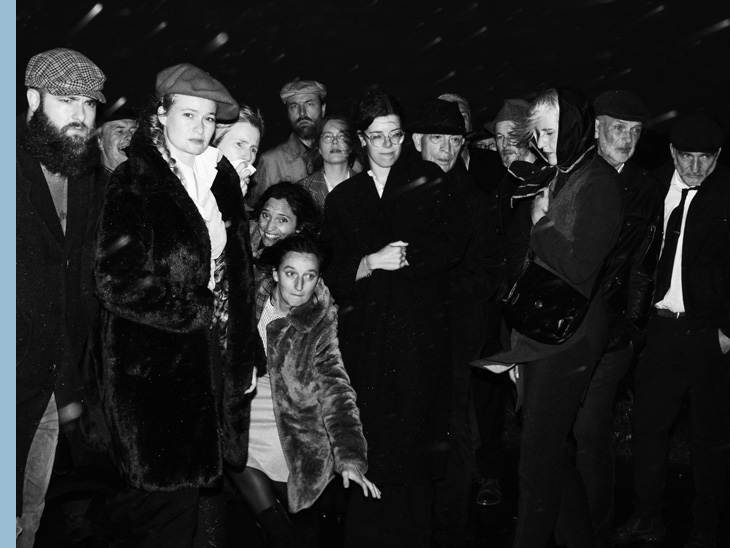TOUR DE FORCE
TOUR is a music project of Belgian musicians Stijn Segers (1977). His collective alter-ego takes place in songs, videos, graphic design, photography, performances and installations. TOUR's musical oeuvre tells stories about places, dealing with real and unreal situations. Reality and fiction often meet in the middle using field recordings and incorporates elements of the local folk music tradition. Mobility and cultural heritage are recurring themes. But TOUR is not only a musical story, it also takes you through history. Their name is also a nod to troubadour, originally a medieval artist, especially gifted as a musician-poet. A certain theory explains the meaning of trobar as “to compose, to invent” and that describes very well what this collective of musicans behind TOUR actually do. When Stijn Segers releases something, you can certainly expect something special. There is always a story that he rigorously extends across the board: in the music, in the artwork, even in the press releases. For example, the nice-looking press photo above, which accompanied his most recent project MUURD, is based on the work of American photographer Weegee. He listened to the police radio in New York and sometimes arrived at the crime scene first, after which he aimed his camera at the reactions of the spectators. He showed the emotions surrounding the murder. That is also what Segers does with MUURD, he tells the story of how the inhabitants of Zutendaal reacted to the murders that took place over the centuries.
I have known Stijn Segers personally for quite some time. Not that we get together for coffee every week, rather sporadically, but the vibe to be creative is palpable when we usually meet by chance. In addition to being a musician, Segers is a self-taught graphic designer with a degree in psychology. He clearly is a self-made man with many exciting projects in his head on which he breeds.
This time I sent him an email asking to talk about TOUR. He was immediately enthusiastic and sent me the latitude and longitude (50°54'21.4"N 5°36'02.7"E) of the place where he wanted to meet. Google Maps gave me a place I'd never been before; Roelerbos in Zutendaal. Zutendaal, how appropriate it could be. We met at a small parking lot and Segers brought an apple pie with pistachios for the road. Delicious isn't it? We walked through the Valley of the Roelerbeek where he introduced me to a beautiful piece of nature with many traces of active beavers.
Manu years ago, Stijn Segers used to do 'pop tourism' with his wife and a friend under the pseudonym Belami. In addition to being a music label, Belami was also an artists' collective with which they also explored certain boundaries. The funny pop songs were a series of repetitive rhythms and melodic sound clips. Today Segers is the driving forces behind TOUR, an electronic indie pop collective that works its way through music, video, photography, design and much more as you can read below.
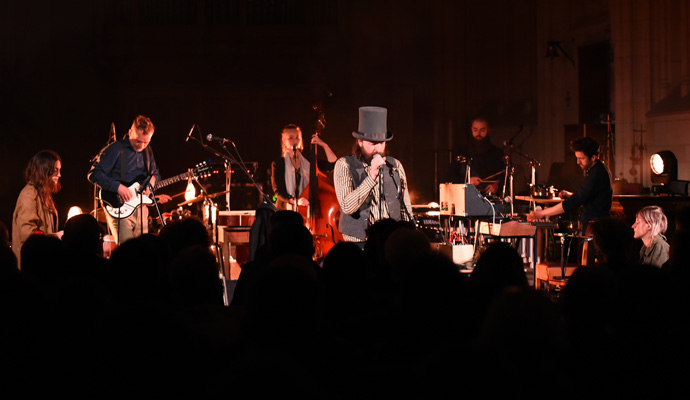
MUURD covers a period from 1740 to 2015. Long enough to fill an entire evening with songs about murder and manslaughter in Zutendaal. Live concert in the village church of Wiemesmeer, a Belgian Limburg community of Zutendaal. The musicians who played along with TOUR for this occasion were Bob Belmans, Dienne Bogaerts, Nelle Bogaerts, Tim Geelen, Loes Gerits, Bert Hornikx, Eva Put, Clemens Put, Gert Stinckens and Ciska Vanhoyland. (Photo: Jolanda Swennen)
MURDER BALLADS
TOUR's latest album, named MUURD (murder) is made up of songs that are inspired by murders that took place from the 18th to the 21st century in and around the small village of Zutendaal. The ballads are all sung in the (disappearing) Zutendaal dialect. Their album was announced in the program book of a nearby cultural center as “an alienating twilight zone between classical, folk and electronica”.
Songwriter Stijn Segers grew up in this village and in this way wants to give a survival to the beautiful but disappearing local dialect and the strong stories surrounding the murders. The songs on MUURD not only tell the stories surrounding the local crimes, like Weegee did, the album also tries to capture the musical zeitgeist with each murder and in doing so makes a journey through local music history in a unique way.
Unlike the murder songs that street musicians brought to the people until the 20th century, MUURD does not focus on the horrific details. However, more abstract images are used, with descriptions of the feelings surrounding the murders, with respect for the victims and relatives. TOUR consists of an eight-piece orchestra and you can hear even more instruments at work in 15 unique songs. One of the very modest, narrative songs is “Twiehfel ên Spikkelaosie” — Doubt and speculation. This song tells the story of the shock wave that went through Zutendaal on the national holiday in 1951 when a passionate murder of the 22-year-old Maria took place.
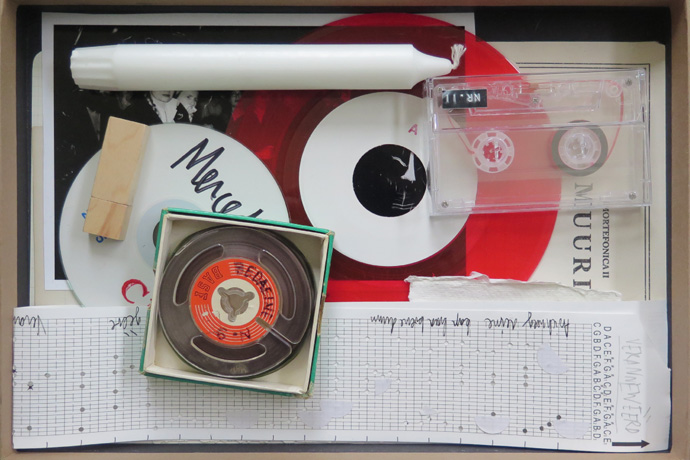
MUURD is also released physically in the form of an archive box with a music carrier from the period of the murder for each song. The box contains scores, a song sheet, a punched card, an engraved wax candle and more recent sound carriers such as a cassette, a CD and a USB stick. It is a unique copy, the archive box travels along at the concerts as a curiosity and as fodder for a discussion about music consumption.
"I found a beautifully handwritten file in the State Archives about the murder. Including situation sketch. A small red spot on the drawing indicates where the bullet hit the victim. While the World Expo opened in Paris in the winter of 1889 and Edison was making sound recordings on top of the Eiffel Tower, they were arguing over a beehive in Zutendaal." — Stijn Segers
“Zwaerem” is about two brothers-in-law who, in the winter of 1889, cannot agree on the ownership of a swarm of bees, with fatal results. The Zutendaal dialect sounds like an old magic language, which gives every song a mystical touch. TOUR allows a lot of influences in their tracks such as organ-like melancholy tearing synth lines and guitar accents that could just as well come from a slow americana song or the use of the theremin and the singing saw.
MUURD was recorded by Bert Hornikx and Stijn Segers in the strange period between April 2020 and June 2021. TOUR's murder ballads sound orchestral strong, seductively sultry and infectiously rhythmic. The album MUURD encourages you to try to understand every word of it, to get the urge to devour history books, but at times also to start dancing to sad stories. It is an artistic work that makes the local history of Zutendaal very accessible, safeguards linguistic heritage and above all shows a sonic gem of expertise. The album has been released digitally and can also be listened to for free on the Tour website. Along with the album was also released a booklet with the lyrics and translations of the songs and a download code. The murder files is only available at the concerts.
Those who would like to hear them live will have to get up early this summer. They play MUURD “Maerge”, a sunrise concert on Monday 11 July at 5 o'clock in the morning at the Zwarteput in Zutendaal. If you think that's too early, you can wait until Sunday 28 August for MUURD “Sjiehmer”, a sunset concert during the MoMeNT Festival, Tongeren/Borgloon.
IT WAS TO NO AVAIL
“Beurtelings speel ik de Mortefonica en de jubilant” — I take turns playing the Mortefonica and the jubilant — wrote the Dutch writer Jeroen Brouwers in his book Zonsopgangen boven zee — Sunrise above sea. The forest villa that the writer has lived in since 1993 was located in a vulnerable nature reserve in Zutendaal. It was demolished in 2017 as well as the birthplace of Stijn Segers' grandmother, once the epicenter of village life as a blacksmith shop and a local pub, in the center of Zutendaal.
Stijn Segers often spent his childhood with his grandmother — she turned 85 († 2006) — in the house that was being demolished for yet another apartment complex. As an ode to his grandmother and the beautiful memories of her in the house, but at the same time as a criticism of the building frenzy of the Zutendaal municipality, TOUR created Mortefonica. It's a soundtrack to the symbolic funeral of her birthplace and a jubilant procession for the funeral of a house.
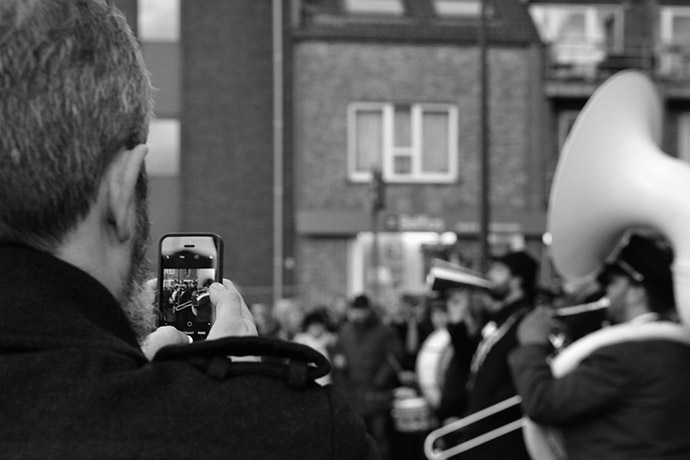
Inspired by the festive tradition of New Orleans Jazz funerals, TOUR wrote ten songs about the house, the village and his grandmother. New Orleans Jazz encompasses collective variations on the pattern of popular songs or blues on a rather wooden, ragtime-inherited rhythmic background. With a brass band, Stijn Segers evoked the funeral ritual: first the sadness at death and then the joy about the happiness that it will be in the afterlife. Together with producer/multi-instrumentalist Micha Volders (Whispering Sons, Gruppo Di Pawlowski, Vermin Twins), the songs were recorded live in the house in one day. The musicians were spread over the different rooms during the recordings and holes were even made in the walls to see each other.
"I lived in Zutendaal for the first twenty years of my life. The warmth of my grandmother are contained in the songs. She was a woman of great love, a beacon of stability and I had many nice conversations with her. The album and the ‘funeral’ are my way of keeping the memories of her alive." — Stijn Segers
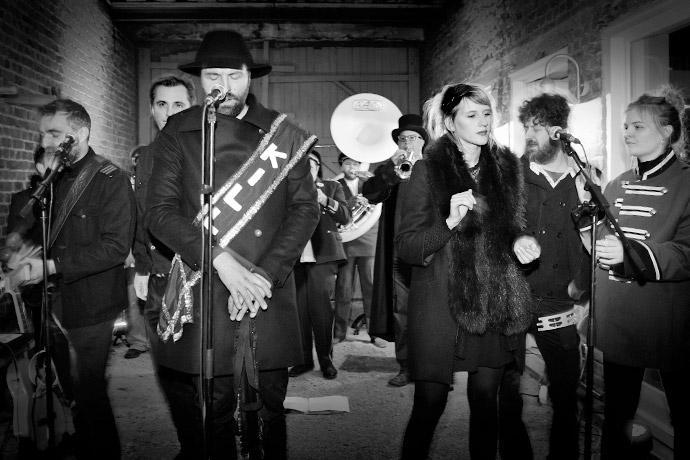
In 2016, about 200 sympathizers said goodbye to the house under musical accompaniment during a solemn live act. A model of the house was then carried in a funeral procession to a nearby cafe. The long playing record was played live in the atmospheric garden of the pub. (Photos Mortefonica: Els Gielen)
When the plan for Mortefonica came about, Segers regularly listened to music from brass bands from New Orleans. The An Amercian television series named Treme also inspired him to come up with the musical project. It examines the survival of the brass band culture after hurricane Katrina, which left a trail of destruction in the city. The demolition of old houses and the resistance of the residents to this are also central. As a result, the album was presented in the form of a 'jazz funeral', a festive procession with brass band and audience. Only 200 copies of the vinyl record were pressed.
TOO MUCH LOVE WILL KILL YOU
On a Sunday in January 1871, Marie Solheid, a maid at the Niezette farm, and François Reiff, a worker at the Gileppes dam, took off to Marie's native village to register for their marriage. They decided to take the shortest route: straight through the High Fens, a rough and dangerous nature reserve with unpredictable weather conditions and a history of mysterious disappearances. They would never reach their final goal. The couple died in the middle of the field, completely disoriented and hypothermic from a sudden snow storm. Their bodies were discovered weeks later by a Prussian border guard. Since then, you will find the Croix des Fiancés (cross of the betrothed or the lover's cross) on that spot, undoubtedly the best known and certainly the most moving cross in the High Fens.
This tragic love story and the beautiful decor inspired TOUR to make four pieces of music that tell the story. Together with producer Luuk Cox, filmmaker and graphic designer Martijn Pillards and singer Dienne Bogaerts, Segers went to the area in September 2012 to shoot a short film, named Fagnards. Fagnards is an astonishing mix of drama, nature documentary and music video that takes place in symbolic places in the story. The four pieces of music were recorded and filmed in a chapel not far from where the couple died. Together with beautiful images of important locations from the lives of the two main characters, the four songs form the common thread for the film. The short film was presented in a symbolic place: the church of Xhoffraix, the village where the couple should have arrived on that fateful day. The presentation of the short film was accompanied by a live concert of the music from the film.
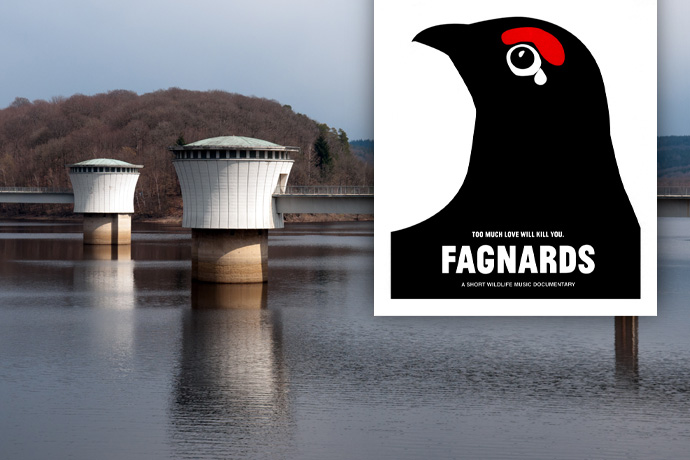
Throughout the story, another pressing problem in the area is interwoven: the extinction of the extremely rare black grouse, a striking bird that is in danger of disappearing from the area due to the increasing presence of humans. In Belgium, the black grouse was found on the moors of the Ardennes and the Kempen. The species already largely disappeared in Wallonia in the 1960s and was then removed from the hunting list. A stylized drawing of the black grouse, symbol of the High Fens-Eifel Nature Park, became the image logo for Fagnards. (Photo Gileppe: Joël Neelen)
Back to Zutendaal. I would like to conclude this somewhat morbid story with a quote from one of the most important writers of post-war Dutch literature to whom I made a reference earlier. Jeroen Brouwers writes a book, and he does it well. There, deep in the forests of Zutendaal, he wrote his book Het leven, de dood (Life, death). And I quote: “Life is worthless, considering that one must die.” Not only people die, even a car factory near Zutendaal — Ciao Mondeo, another TOUR project about the departure of the production of the Ford Mondeo to Spain — or a house often has a sad end. Or am I a bit too morbid?
All images courtesy of the artist.
More story related movies/interviews:
Related stories on Woodland:
